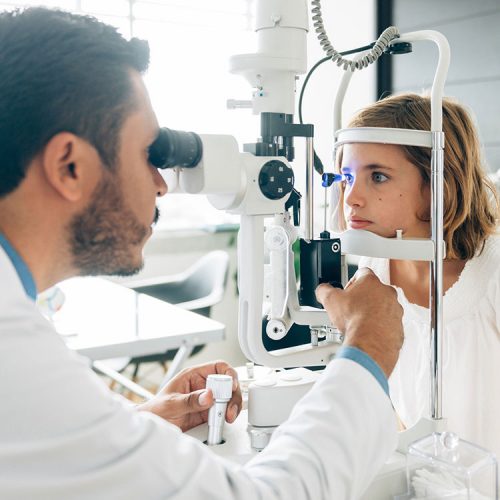Every parent wants to give their child the best chance to have a healthy and productive life. Did you know that regular eye exams are key to achieving this goal?
Early detection and treatment provide the best chance to prevent permanent vision loss and correct problems before they cause difficulties academically, socially, and athletically. Poor vision can impact learning when children cannot easily read books, see the chalkboard or view a computer screen. Poor vision can also impair eye-hand coordination needed for writing, drawing, and sports. And vision problems can also cause behavioral issues.
Common childhood eye problems include amblyopia (lazy eye), strabismus (a misalignment of the eyes causing one or both to turn in, out, up or down), and refractive errors that result in nearsightedness, farsightedness, or astigmatism.
Since vision may change often during school years, frequent eye and vision care is vital.
A schedule for routine eye exams
- Newborns should be checked soon after birth in the hospital nursery. High-risk newborns (including premature infants), those with a family history of eye problems and those with obvious eye irregularities should be examined by an eye specialist.
- In the first year of life, all infants should be routinely screened for eye health during checkups with their pediatrician or family doctor.
- Around age 3½, kids should have eye health screenings and visual acuity tests (tests that measure sharpness of vision) with their pediatrician or family doctor.
- Around age 5, kids should have their vision and eye alignment checked by their pediatrician or family doctor. Those who fail either test should be examined by an eye doctor.
- After age 5, routine screenings should be done at school and the primary doctor’s office, especially if symptoms such as squinting or frequent headaches occur. (Many times, a teacher will notice that a child isn’t seeing well in class.)
- Kids who wear prescription glasses or contacts should have annual checkups by an eye doctor to screen for vision changes.
How to spot eye problems
- Constant eye rubbing
- Extreme light sensitivity
- Poor focusing
- Poor visual tracking (following an object)
- Abnormal alignment or movement of the eyes (after 6 months of age)
- Chronic redness or tearing of the eyes
- A white pupil instead of black
In school-age children, other signs to watch for include:
- Trouble reading the blackboard
- Squinting
- Difficulty reading, including confusing similar words and persistent word reversal
- Sitting too close to the TV
- Behavioral problems like avoiding reading as much as possible, inattentiveness, short attention span, fatigue and acting out
Glasses and contact lenses
While eye patches and surgery are sometimes recommended, the above vision problems can usually be corrected with glasses or contact lenses. Here are some tips to consider when buying these for children:
- Let kids pick their own frames.
- Plastic frames are best for children younger than 2.
- If older kids wear metal frames, make sure they have spring hinges, which are more durable.
- An elastic strap attached to the glasses will help keep them in place for active toddlers.
- Polycarbonate lenses, which are tough and shatterproof, are best for all kids, especially those who play sports. Although very impact-resistant, they may scratch more easily than plastic lenses.
As your child gets older, he or she may want to get contact lenses for cosmetic reasons. It’s very important that children and teens know how to properly insert and remove lenses, use good hygiene, and clean the lenses properly. Your eye doctor can help you decide what type of vision correction is best for your child. Remember: frequent vision exams throughout childhood are important to maintain eye health and can boost your child’s chances for academic and social success.
